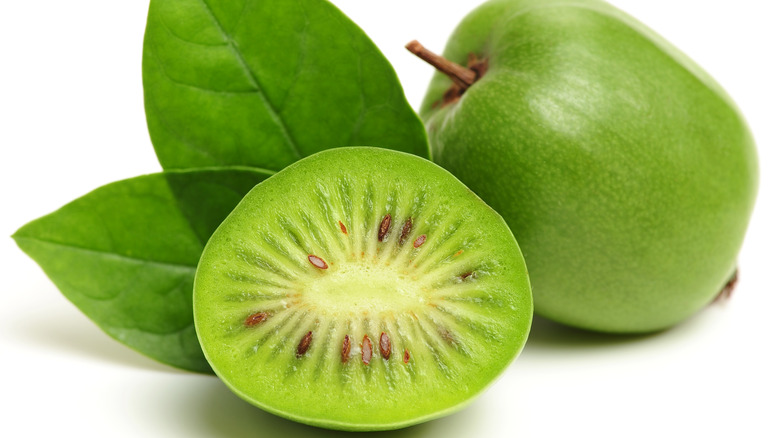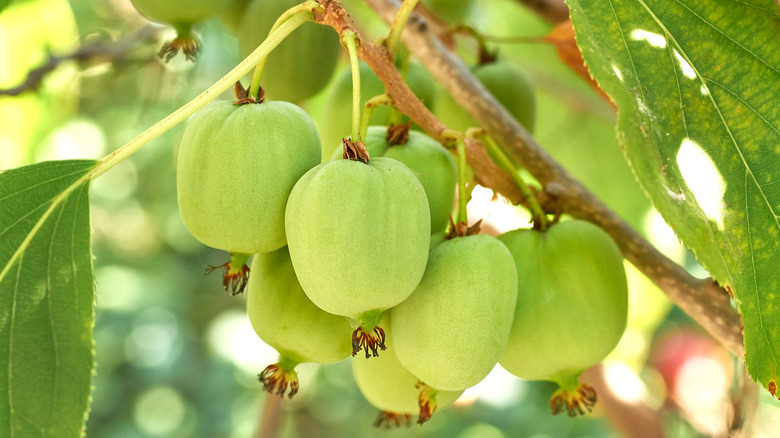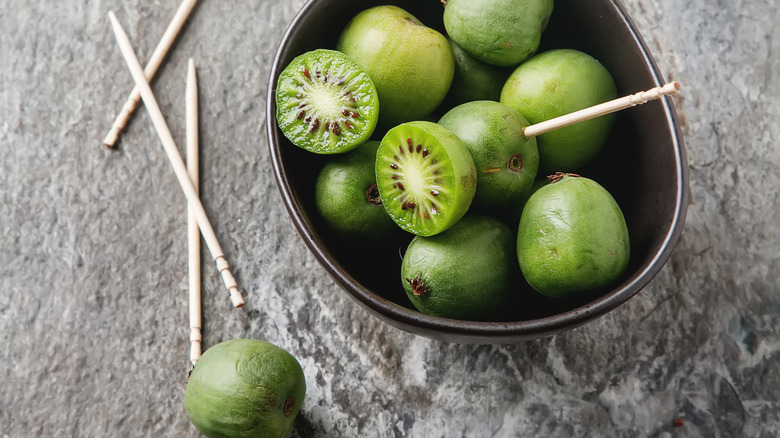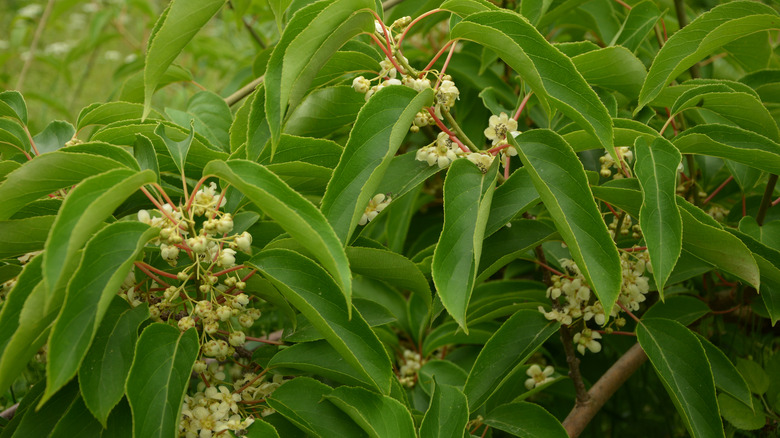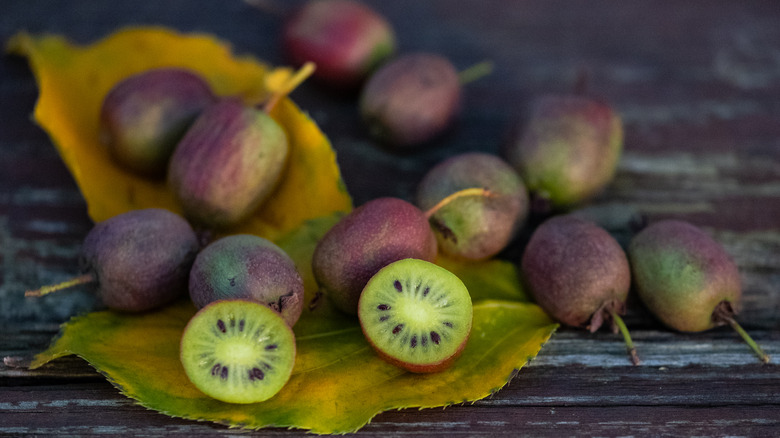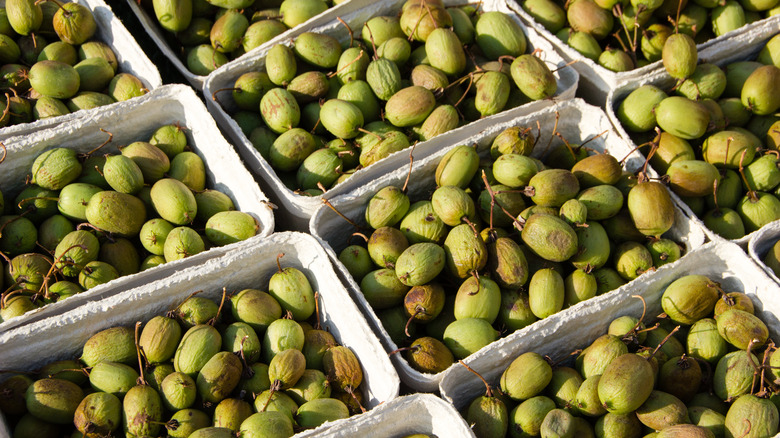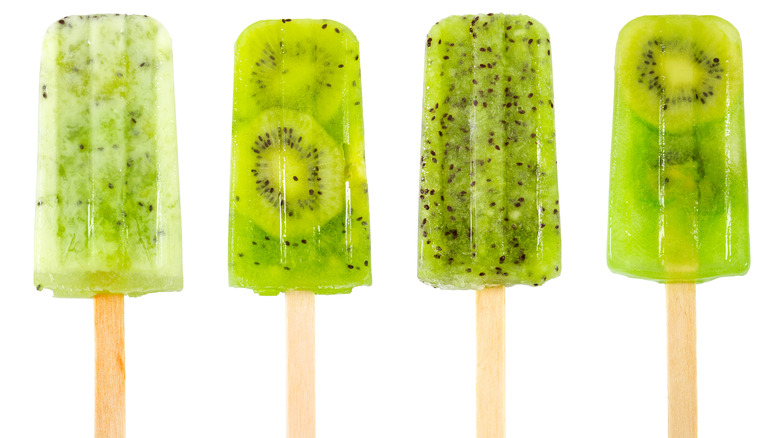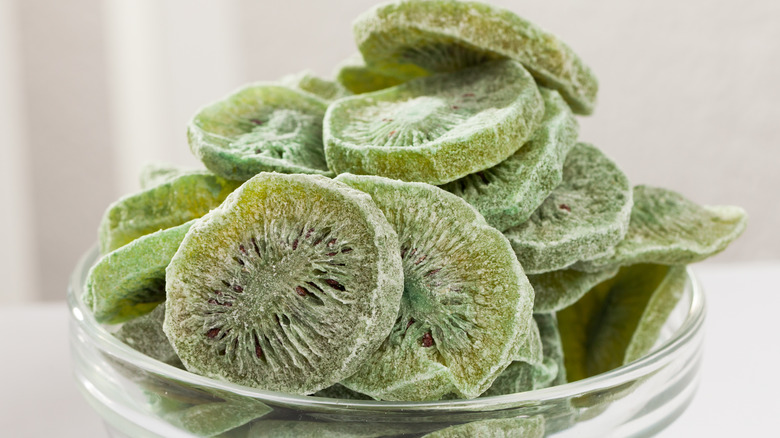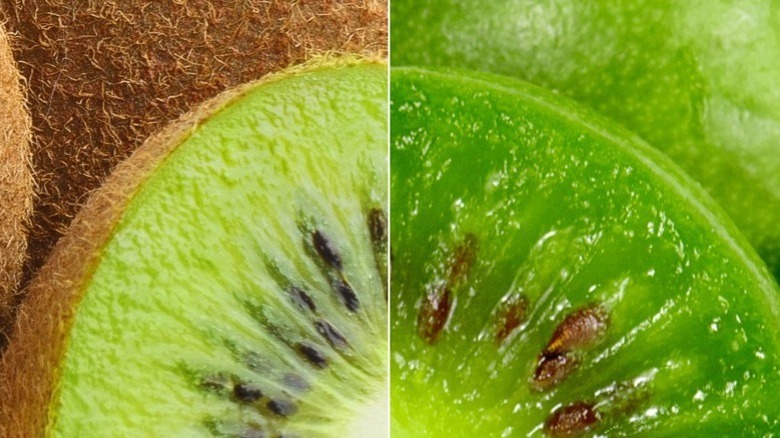Kiwi Berries: Everything You Need To Know
We may receive a commission on purchases made from links.
It's time to move over, kiwi. With their high amount of antioxidants, kiwi berries might be the next new superfood in town (via Food Science & Nutrition).
Yes, you heard that right. Not exactly a kiwi but not quite all berry either, kiwi berries are one food trend that you definitely don't want to miss out on. If you love kiwi fruits but hate the tedious process of peeling each fruit before eating, kiwi berries are the perfect alternative. Despite this, most people haven't even heard of them.
While similar to kiwi fruits on the inside with their signature green flesh and black seeds, kiwi berries are fuzz-free on the outside with smooth, edible skin. However, just like regular kiwis, you can virtually pair the adorable kiwi berries with anything, savory or sweet, and it will still taste delicious.
So, what in the world is a kiwi berry, what do they taste like, and where can you go looking for one? Well, let's find out!
What exactly are kiwi berries?
Imagine a teeny tiny version, the size of a grape, of the good old kiwi fruit but without the fuzzy exterior. That's precisely what a kiwi berry looks like.
According to Taste of Home, kiwi berries are small, round, light-green fruits. You can eat these fruits on their own, use them in your fruit salad bowl, or perhaps on a fancy cheese board. With the size of a grape, the taste of a kiwi, and skin like an apple, kiwi berries offer all the goodness of a kiwi without the hassle of peeling the fuzzy skin. The no-peeling required makes them perfect for eating on the go. Simply pop one in your mouth as a quick and delicious snack.
Kiwi berries are pretty tough, though: They are resistant to the cold and can survive in temperatures as low as -40 degrees Fahrenheit. Since kiwi berries are so resilient, they also go by another name: "hardy kiwi" (via The National Gardening Association).
What do kiwi berries taste like?
While you cannot directly pop a kiwi in your mouth, you can certainly do that with a kiwi berry. Once you pop the fruit in your mouth, get ready to experience an intensely layered flavor that will hit your taste buds just right.
Although Taste of Home defines the taste of a kiwi berry as slightly sweet, Allrecipes identifies the taste of kiwi berry as a bit more acidic than the kiwi fruit. No matter the taste, however, you are guaranteed to be enjoying a delicious fruit when you eat a kiwi berry. The only difference is that they haven't got the fuzz to peel off (though kiwi fuzz is actually edible and incredibly nutritious, according to The European Journal of Nutrition).
The flesh of the kiwi berry is dark green with black seeds arranged just like in the kiwi fruit. The berry imparts a fruity aroma when you cut it open. Not only that, but the fruit's flesh is juicy, making it an excellent choice for smoothies and salads. And, these kiwi berries are the perfect substitute for people who do not like the sourness of the kiwi fruit. The suggestion is valid since these little berries do not have the tartness of the kiwi fruit but instead a delicious, fully sweet taste.
Where do kiwi berries come from?
So, where do these delicious berries come from? Let's look at where its plant family, Actinidiaceae (via North Carolina State University), is commonly found. Actinidia arguta, the technical name for kiwi berries, typically grows on the Southwestern hills of China. Since the plant is highly resistant to the cold, it can also be found in Siberia. Currently, New Zealand is home to nearly 90% of the total kiwi berry growth worldwide (via Ohio State University).
Besides China, New Zealand, and Siberia, kiwi berries can be cultivated right here in the U.S. as well. According to Minnesota Fruit Research, horticulturists in the Minnesota region started planting kiwi berries as an experimentation cultivar in 1892. Apart from Minnesota, the fruit gained immense popularity in Washington state in the 1980s, according to Edible Seattle. In their report, they write that Michael Dolan of Burnt Ridge Nursery started cultivating the plant after buying its vines from an Aurora research center.
You might be surprised to know that kiwi berries have actually been growing in the U.S. for nearly 150 years. But it wasn't until the late '80s that these berries were commercialized. Currently, kiwi berries are grown all over the U.S. in areas with cooler climates. However, we are arguably still more accustomed to the fuzzy, brown kiwi fruit, which was also brought to the U.S. from New Zealand.
Health benefits of kiwi berries
Don't let the miniature size of kiwi berries fool you. These berries are more than just healthy. They could be considered a nutritional powerhouse.
An article published in Plant Foods Human Nutrition Journal in 2017 noted that the kiwi berry has over 20 essential nutrients and is loaded with vitamins. The superfood status of kiwi berries is primarily due to their high levels of antioxidants. According to a study published in Food Science & Nutrition, the antioxidants present in kiwi berries are touted for their anti-inflammatory and anti-cancer properties. The same research also suggests that kiwi berries help maintain cholesterol levels and improve gastrointestinal health.
Additionally, the most notable amount of vitamin that kiwi berry contains is vitamin C. Per The Mayo Clinic, vitamin C is an antioxidant that can prevent diseases such as Type I diabetes and certain heart diseases. These diseases are often caused by free radical molecules. Besides that, vitamin C can also help absorb iron in your body, which can be extremely beneficial for individuals suffering from anemia.
When and where can you buy kiwi berries?
Since kiwi berries are rapidly becoming a household name, you can often find them in the fresh produce aisle of your grocery stores. However, it could be challenging to locate them in some places. Kiwi berries are short-lived and are usually available in the market in September and part of October only (via Better Homes & Gardens). Besides the short supply span of kiwi berries, they also have a short shelf life, making it difficult for stores to stock up on the fruit.
Still, you might get lucky and find them in some grocery stores like Trader Joe's or Sam's Club from February to March, as they can be imported from New Zealand. What's more, the vine seed is also available on Amazon. So if you're big on gardening, give the hardy vine a try.
Apart from these places, you're most likely to find kiwi berries at your local fruit sellers, natural food stores, Asian grocery stores, and farmer's markets.
How can you eat kiwi berries?
When it comes to eating kiwi berries, you can simply eat them on their own as they make for a delicious and easy go-to snack. However, the best way to eat raw kiwi berries is to let them ripen first, according to HBF International. The ripening process can be achieved by placing the kiwi berries at room temperature. Once ripened, the fruit's skin will turn dark green and softer to touch.
NZ KiwiBerry makes a critical point here: You should never keep the unripened fruit with another fruit that releases ethylene, including apples and kiwi fruit itself. Keeping kiwi berries with these fruits will cause them to spoil much earlier than their true shelf life.
Besides eating ripened kiwi berries raw, NZ KiwiBerry also says you can incorporate the fruit into a salsa by taking equal numbers of cherry tomatoes and kiwi berries and chopping them roughly. You can use a sharp knife over a chopping board to accomplish this. Afterward, you can chop up some cilantro and add it to your fruits. Finally, you can season the salsa with salt, sugar, and lemon juice.
You can substitute kiwi berries in every recipe that calls for a kiwi fruit like salads, jams, ice creams, lollies, smoothies, or desserts. Furthermore, you can also use kiwi berries to garnish your cocktail and top your pizza if you feel extra fancy.
How long do kiwi berries stay fresh for?
It generally depends on how you store them. You can leave kiwi berries at room temperature if you plan to eat them in the next 24 hours or so, but after that, you should transfer them to the fridge — they can stay there for up to two weeks (via the University of Minnesota). According to The Daring Kitchen, it is recommended that you put them in a paper bag to ensure the fruit stays moisture-free in the refrigerator.
Choose unripened kiwi berries since they are pretty easy to ripen at home and stay fresh for longer. However, do not leave the fruit for more than a day because it will spoil if kept for too long.
You can also freeze your kiwi berries to make them last longer. As per FoodsGuy, frozen kiwi berries will last for up to 12 months. You can start by rinsing and drying your kiwi berries. Next, try arranging the berries neatly on a tray lined with parchment paper. You can then freeze the berries overnight. Once done, transfer your pre-frozen berries to freezer storage bags or airtight containers and straight into the freezer. Make sure you label and date your storage items.
Freezing your kiwi berries is a great way to stock up on them while they are in season and enjoy them later without worrying about them going bad.
Kiwi vs. kiwi berries: what's the difference?
The kiwi fruit grows on woody vines just like the Hardy Kiwi, but the Kiwi fruit's vines are not as cold-hardy as the kiwi berry vines. Similarities in the fruits include their flesh color, the black seeds arranged in a ring, and the ripened form, which is soft to touch. Kiwi berries are also a fantastic source of vitamin C (via Plant Foods for Human Nutrition).
As Insider points out, kiwi berries are 'just mini kiwis'; the sizes of the fruits differ from each other. Kiwi fruits can grow up to 7.5 cm in length, while kiwi berries are about the size of grapes. According to HBF International, kiwi berries are balder and smaller than regular kiwi fruits. These berries are also a better alternative to eat whole because their hair does not get stuck between the teeth like that of regular kiwis.
Perhaps the best thing about these bite-sized berries is their low-calorie count, according to My Fitness Pal. With only 61 calories in half a cup of kiwi berries, you can devour them guilt-free without worrying much about weight gain.
This delicious taste is why you definitely don't want to miss out on this underrated but tasty fruit. Just as juicy as their grown-up counterparts and maybe even sweeter, these no-fuss fruits are a delicious and quick on-the-go snack that you'll absolutely fall in love with.
